中职英语导学案Book1Unit9 Lesson1-2
- 格式:doc
- 大小:29.00 KB
- 文档页数:2
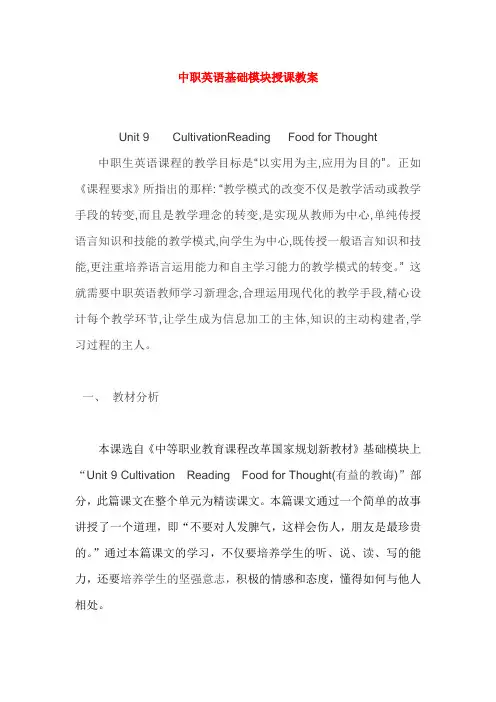
中职英语基础模块授课教案Unit 9 CultivationReading Food for Thought 中职生英语课程的教学目标是“以实用为主,应用为目的”。
正如《课程要求》所指出的那样: “教学模式的改变不仅是教学活动或教学手段的转变,而且是教学理念的转变,是实现从教师为中心,单纯传授语言知识和技能的教学模式,向学生为中心,既传授一般语言知识和技能,更注重培养语言运用能力和自主学习能力的教学模式的转变。
”这就需要中职英语教师学习新理念,合理运用现代化的教学手段,精心设计每个教学环节,让学生成为信息加工的主体,知识的主动构建者,学习过程的主人。
一、教材分析本课选自《中等职业教育课程改革国家规划新教材》基础模块上“Unit 9 Cultivation Reading Food for Thought(有益的教诲)”部分,此篇课文在整个单元为精读课文。
本篇课文通过一个简单的故事讲授了一个道理,即“不要对人发脾气,这样会伤人,朋友是最珍贵的。
”通过本篇课文的学习,不仅要培养学生的听、说、读、写的能力,还要培养学生的坚强意志,积极的情感和态度,懂得如何与他人相处。
二、学情分析我所教的班级是高一的新生,他们大多数英语基础比较薄弱, 运用英语进行交际活动的能力较差,主动学习的动力不够,然而他们的好胜心强,渴望在班集体里得到他人的承认,很在乎别人对他们的评价,求知欲旺盛,思维比较活跃。
因此,只有设置使他们感兴趣的活动,因材施教,尊重学生的个体差异,适应学生的个性发展需求,寻找适应他们的教学策略。
才能使每个学生均学有所得。
三、教学目标1. 认知目标⑴通过课文的学习,掌握下列词汇的用法have fights with lose one’s temper keep one’s temper the number of a number of not … at allbe able to⑵理解宾语从句的构成,it 做形式主语的句式⑶能较流畅地朗读课文,理解课文内容,了解文章的中心思想。
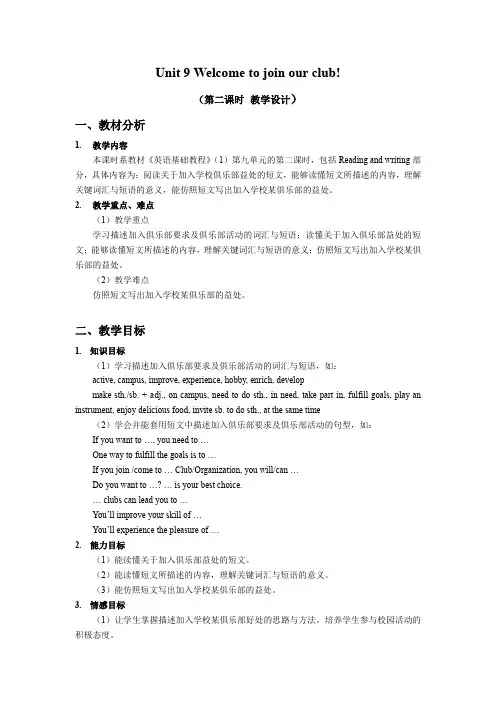
Unit 9 Welcome to join our club!(第二课时教学设计)一、教材分析1.教学内容本课时系教材《英语基础教程》(1)第九单元的第二课时,包括Reading and writing部分,具体内容为:阅读关于加入学校俱乐部益处的短文,能够读懂短文所描述的内容,理解关键词汇与短语的意义,能仿照短文写出加入学校某俱乐部的益处。
2.教学重点、难点(1)教学重点学习描述加入俱乐部要求及俱乐部活动的词汇与短语;读懂关于加入俱乐部益处的短文;能够读懂短文所描述的内容,理解关键词汇与短语的意义;仿照短文写出加入学校某俱乐部的益处。
(2)教学难点仿照短文写出加入学校某俱乐部的益处。
二、教学目标1.知识目标(1)学习描述加入俱乐部要求及俱乐部活动的词汇与短语,如:active, campus, improve, experience, hobby, enrich, developmake sth./sb. + adj., on campus, need to do sth., in need, take part in, fulfill goals, play an instrument, enjoy delicious food, invite sb. to do sth., at the same time(2)学会并能套用短文中描述加入俱乐部要求及俱乐部活动的句型,如:If you want to …, you need to …One way to fulfill the goals is to …If you join /come to … Club/Organization, you will/can …Do you want to …? … is your bes t choice.… clubs can lead you to …You’ll improve your skill of …You’ll experience the pleasure of …2.能力目标(1)能读懂关于加入俱乐部益处的短文。
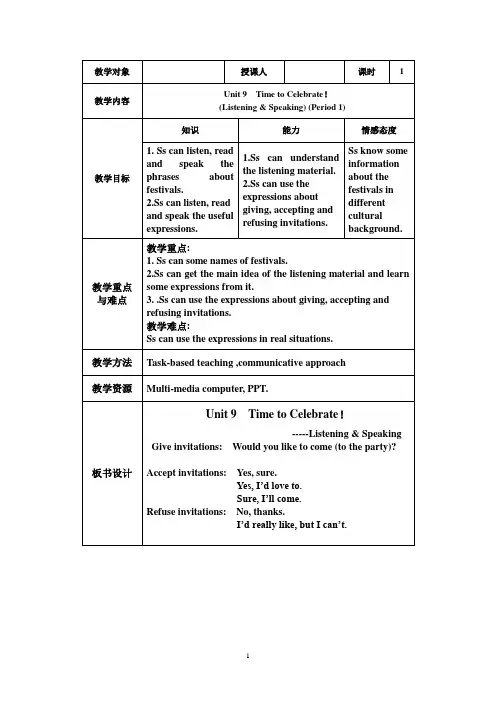
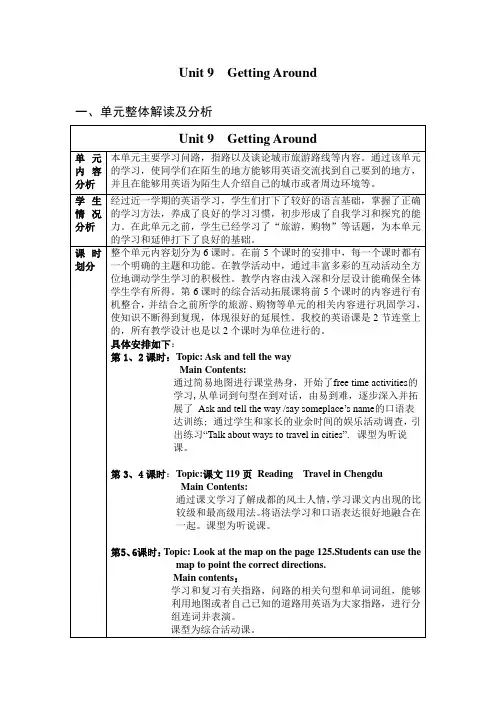
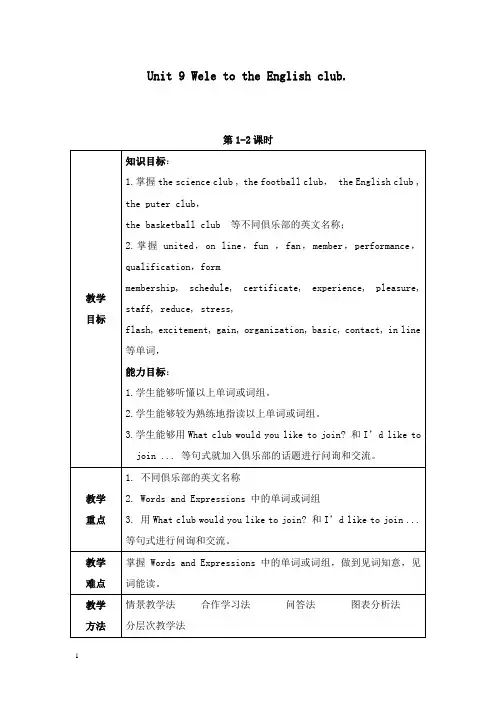
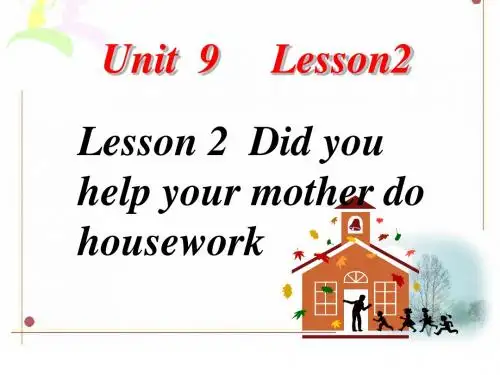
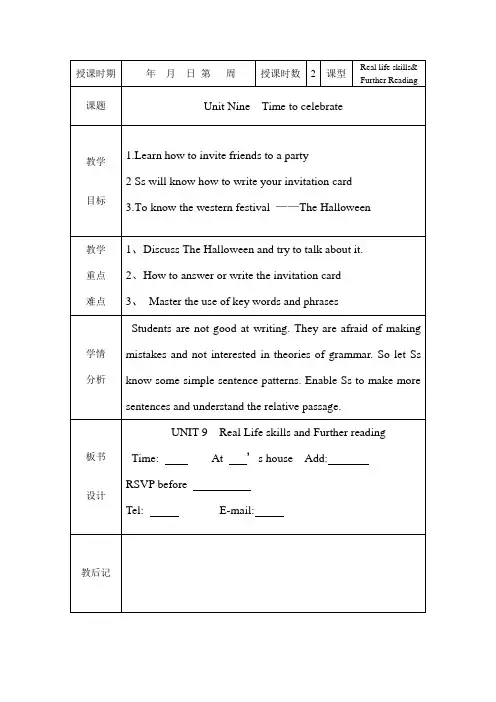

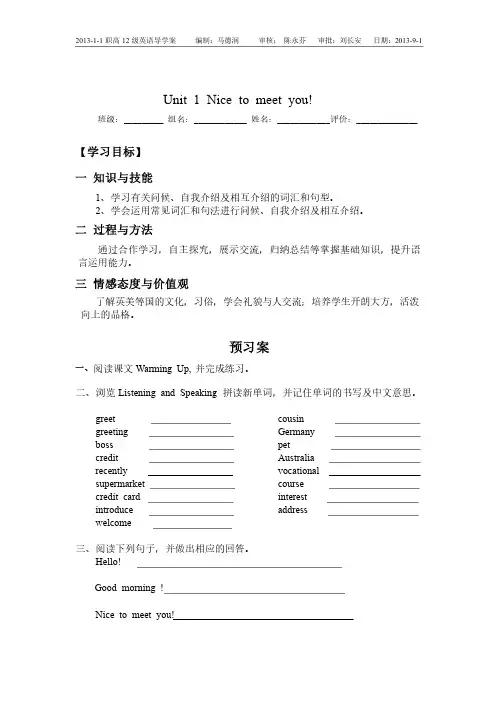
Unit 1 Nice to meet you! 班级:_________ 组名:____________ 姓名:____________评价:______________ 【学习目标】一知识与技能1、学习有关问候、自我介绍及相互介绍的词汇和句型。
2、学会运用常见词汇和句法进行问候、自我介绍及相互介绍。
二过程与方法通过合作学习,自主探究,展示交流,归纳总结等掌握基础知识,提升语言运用能力。
言运用能力。
三情感态度与价值观了解英美等国的文化,习俗,学会礼貌与人交流;培养学生开朗大方,活泼向上的品格。
向上的品格。
预习案一、阅读课文Warming Up, 并完成练习。
并完成练习。
二、浏览Listening and Speaking,拼读新单词,并记住单词的书写及中文意思。
,拼读新单词,并记住单词的书写及中文意思。
,拼读新单词,并记住单词的书写及中文意思。
greet greeting boss credit recently supermarket credit card introduce welcome cousin Germany pet Australia vocational course interest address 三、阅读下列句子,并做出相应的回答。
Hello! Good morning ! Nice to meet you! How do you do ? My name is Mary Smith. How are you ? Hi! How are things? How is everything? Hi! How is it going ? 四、大声朗读下面的句子。
四、大声朗读下面的句子。
1、Let me introduce him to you. Let me introduce her to you. I’d like to introduce him to you.I’d like to introduce her to you.2、This is Tom. He is my cousin. This is Wang Fang. She is my English teacher. 3、He is from Qingdao. He is a doctor. She is from England. She is a teacher. 探究案探究一【Listening and Speaking】完成课本第2—3页Task1、Task2 、Task3;第4---5页Task1、Task3、Task4 。
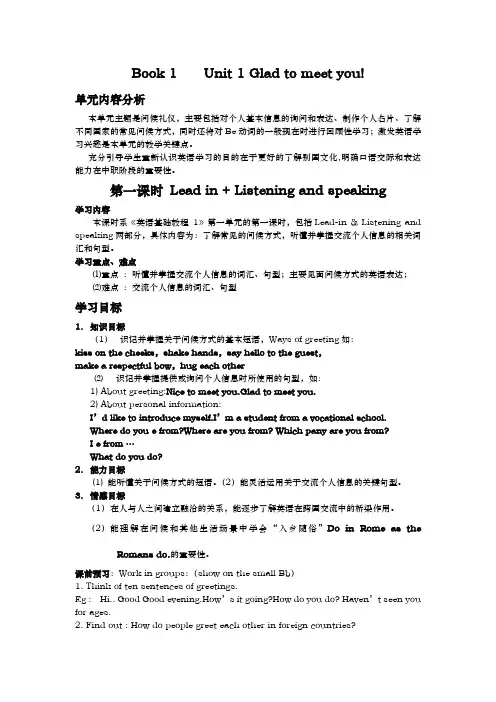
Book 1 Unit 1 Glad to meet you!单元内容分析本单元主题是问候礼仪,主要包括对个人基本信息的询问和表达、制作个人名片、了解不同国家的常见问候方式,同时还将对Be动词的一般现在时进行回顾性学习;激发英语学习兴趣是本单元的教学关键点。
充分引导学生重新认识英语学习的目的在于更好的了解别国文化,明确口语交际和表达能力在中职阶段的重要性。
第一课时Lead in + Listening and speaking学习内容本课时系《英语基础教程1》第一单元的第一课时,包括Lead-in & Listening and speaking两部分,具体内容为:了解常见的问候方式,听懂并掌握交流个人信息的相关词汇和句型。
学习重点、难点⑴重点:听懂并掌握交流个人信息的词汇、句型;主要见面问候方式的英语表达;⑵难点:交流个人信息的词汇、句型学习目标1.知识目标(1)识记并掌握关于问候方式的基本短语,Ways of greeting如:kiss on the cheeks,shake hands,say hello to the guest,make a respectful bow,hug each other⑵ 识记并掌握提供或询问个人信息时所使用的句型,如:1) About greeting:Nice to meet you.Glad to meet you.2) About personal information:I’d like to introduce myself.I’m a student from a vocational school.Where do you e from?Where are you from? Which pany are you from?I e from …What do you do?2.能力目标(1)能听懂关于问候方式的短语。
(2)能灵活运用关于交流个人信息的关键句型。
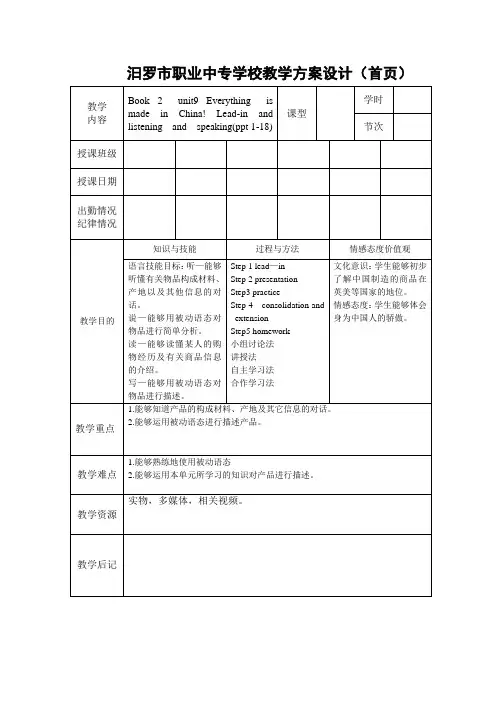
汨罗市职业中专学校教学方案设计(首页)教学内容Book 2 unit9 Everything ismade in China! Lead-in andlistening and speaking(ppt 1-18)课型学时节次授课班级授课日期出勤情况纪律情况教学目的知识与技能过程与方法情感态度价值观语言技能目标:听—能够听懂有关物品构成材料、产地以及其他信息的对话。
说—能够用被动语态对物品进行简单分析。
读—能够读懂某人的购物经历及有关商品信息的介绍。
写—能够用被动语态对物品进行描述。
Step 1 lead—inStep 2 presentationStep3 practiceStep 4 consolidation andextensionStep5 homework小组讨论法讲授法自主学习法合作学习法文化意识:学生能够初步了解中国制造的商品在英美等国家的地位。
情感态度:学生能够体会身为中国人的骄傲。
教学重点1.能够知道产品的构成材料、产地及其它信息的对话。
2.能够运用被动语态进行描述产品。
教学难点1.能够熟练地使用被动语态2.能够运用本单元所学习的知识对产品进行描述。
教学资源实物,多媒体,相关视频。
教学后记汨罗市职业中专学校教学方案设计(正页)教学程序重、难点诠释、教学方法等Step1 lead-inActivity 1 Match the objects with their materials.选用方框中的单词描述图片。
glass cotton plastic wood stone wool silk steel leather1.教师先让学生对着单词表的单词中文意思做题。
2.教师点名检查学生完成情况并给出反馈。
3.教师可以带学生朗读这些句子,让学生初步了解用be made of 表示物品的构成材料,为下面的活动做铺垫。
Activity 2 Match the questions with their answers.将左栏问题与右栏回答匹配,完成顾客与售货员之间的对话。
Unit 9 May I help you?(第二课时教学设计)一、教材分析1.教学内容本课时系教材《英语1》(基础模块高教版)第九单元的第二课时,包括reading and writing部分,具体内容为:了解服务场所,服务人员以及服务用语,读懂各种类型的单据2.教学重点、难点⑴教学重点阅读各种类型的单据。
⑵教学难点在阅读过程中正确理解并提取相关信息完成任务。
二、教学目标1.知识目标⑴掌握服务人员名称词汇,如secretary, receptionist, shop assistant, cashier, waiter, waitress, doctor, nurse⑵掌握如何用英语在不同场合提供或获得服务的句型:What’s wrong with you?I have a bad headache.Can I take your order now?Can I help you?What can I do for you?2.能力目标a)学生能读懂并提取不同单据上的相关信息;b)在日常生活中灵活应用在不同场合提供或获得服务的英语表达方式。
3.情感目标学生了解在不同的场合,针对不同对象所使用的服务语言。
三、教学步骤Step One Lead-in1. Activity 1: The students look at the pictures, identify the places and write down the names who offer services in such places.(设计意图:复习第一课时教学内容,让学生学会用英语表达服务场所及服务人员。
既巩固了词汇,又为后面的阅读活动作铺垫和准备。
)2. The teacher brainstorms more places where services are provided and the people who serve others. The teacher may also ask the students where they will work after graduation and what they will do.(设计意图:这个活动是一个开放练习,教师要鼓励学生充分发挥想像力来丰富语境,并借此补充相关的词汇。
1课题 Unit 9 Cultivation /words学习目标:(一)知识目标:Learn the words in this unit.(二)能力目标:Master the use of some of the important words and expressions 灵活掌握重要词语的用法(三)情感目标:通过小组合作学习增强集体、合作、竞争意识。
Step1: 导入(2 minutes) Revision or free talk. Step2: 自学(10 minutes)(1)Get the Ss to read the words by themselves, then in groups.(2)Check their reading.(3)Emphasis the pronunciation of the words.Step3:讨论 (15 minutes) Discuss in groups with your teammates. (1)Explain some of the words.(单词短语释义)1)quarrel with A. a kind of personalities of sb.2)happen B. have words with3)apologize C. in anger4)angrily D. take place or occur5)temper E. unusual; uncommon6)rare F. to use or have with others7)share G . a tool used to drive 8)fault H. make an apology 9)hurt I. injure10)hammer J. mistakes (2)根据要求写出单词1-8写出过去式和过去分词1)think--_________--__________ 2)lose--___________--______________ 3)lead--_________--___________4)drive-- __________--______________ 5)hurt --__________--__________6)mean --__________--______________ 7)catch--_________--__________8)beg-- ___________--______________ 9)think(名词)______________ 10)follow(形容词)__________________ 11)apologize(名词)_____________ 12)mean(名词)_________________ 13)anger (形容词)__________________ (副词) ________________(3)Make up some phrases.(编组短语)1)发脾气_______________________2)不发脾气_____________________________ 3)能够_____________________ 4)在随后几天里_____________________________ 5)与…斗争/打仗____________________6)与…吵嘴_________________________ 7)抓住某人的手_______________________8)生气地__________________________ 9)即使;尽管_______________________10)与…相处_________________________ 11)坏脾气男孩______________________12)故意地___________________________ 13)把钉子钉入…______________________14)根本不_________________________ 15)拔出钉子______________________16)带领某人去某地_____________________ 17)与…一样______________________18)学会做某事________________________ 19)有益的教诲________________________(4)Make sentences with the following words or phrases.(用下列单词或短语造句子) ①temper________________________________________________________________________________________________________________________________________ ②be able to____________________________________________________________________ ③lead____________________________________________________________________ ④anger__________________________________________________________⑤even if / even though___________________________________________________________________ Step4:展示(15 minutes) Please show your answers to the whole class. Step5:点评Step6:检测(3 minutes)Read the first part of the words.Step7:反思 Write down what you have learned today on your notebooks(整理笔记) Step8:应用1. Don ’t ______ your temper when you are in trouble. A. lose B. keep C. lost D. kept2. He won ’t give up ______ he has failed many times. A. since B. even if C. whether D. until2单词拼写/词形变换1.When we meet difficulties, we should keep our _______________(脾气).2.We should learn how to _______________(道歉) to others.3. Do you know the ______________ (mean) of the word?4. His father ’s advice gave the boy food for ____________(think).5.The taxi ____________(drive) works more than 12 hours a day.6. Don ’t say anything when you are in ______________(生气).7. He helped a lot of people in the ____________(follow) days.8. This book is as same as that one.(改错)A B C D3课题 Unit 9 Cultivation /Reading(Ⅰ)学习目标:(一)知识目标:Train and improve the reading ability of the students . (二)能力目标:Have the students master some reading skills.(三)情感目标:Keep one ’s temper when you ’re in trouble, which is good for health. Step1: 导入(2 minutes) A brief introduction about Patrick . Step2: 自学(15 minutes)① ReadingGet the Ss to read the passage and finish the exercises on page71. ②Read the text and translate/analyze the following sentences.1)His father told him to hammer a nail into the fence every time he lost his temper. _____________________________________________________________________2) …and his father asked him to pull out one nail each time he was able to keep his temper.3)The boy listened and did what his father told him to do._____________________________________________________________________ 4)The boy found that it was easier to keep his temper than to drive the nails into the fence._____________________________________________________________________ 5)Finally, the day came when the boy didn ’t lose his temper at all._____________________________________________________________________ 6)The fence will never be the same as it was before._____________________________________________________________________ 7) When you say some words in anger, your bad temper will leave a scar just like the hole. Even if you say you ’re sorry, the wound is still there. If you hurt a person with words, the wound is as bad as a physical one.______________________________________________________________________________________________________________________________________ Step3:讨论 (8 minutes) Discuss in groups with your teammates. Step4:展示(12 minutes) Please show your answers to the whole class. Step5:点评Step6:检测(3 minutes) Read the text aloud.Step7:反思 Write down what you have learned today on your notebooks(整理笔记) Step8:应用 (5分钟)Read the text again and then fill in the blanks:There was once a little boy _____ ______ ______ ______. He often had_______with his friends. One day, his father gave him_____ ______ ______ ______ and told him to hammer a nail into the fence ______ ______he ________his temper. The boy did________ his father told him to do.Finally, the day came when the boy didn ’t _______ his temper at all. He told his father about it and his father asked him _______ ______ _______ one nail each time he _______ ________ _______ keep his temper. The days passed and the boy finally told his father that all the nails ________ ________. His father _______ him to the fence. He said that the fence would never be _______ _______ ________ it was before because of the nails. His father also told his son that bad temper will _______ a scar just like the holes. If he hurt a person _______ ________, the wound is ______ _______ _______ a physical one. From this story, the boy learned _______ ______ _______ ______with others and never lost his temper _________.。
中职英语导学案B o o k1U n i t9-L e s s o n-3-4Unit9 Past Events 过去的事情Lesson 3-41. Describe past events正确使用动词过去式描述过去的事情2. can write a letter of apology能写道歉信Step1 预习本单元语法1、一般过去式的用法:1)______________________________________________________2)______________________________________________________2、常用一般过去式的时间状语:_________________________________________________________3、动词过去式的构成方法:Task 2 写出下列动词的过去式am, is—____________ are—____________ go—____________ do—___________ have—_____________ come—____________take—__________ say—______________ eat—_____________ see —___________ get—______________ put—____________sleep—_____________ give—______________ write—___________ read—_____________ find -- ____________ make --___________hear -- ___________ run --_____________ take -- _____________hold -- ___________ speak —___________ leave -- ____________keep -- ___________ sleep -- ____________ sweep -- ___________tell -- ____________ sell -- _____________ begin -- ___________sing -- ____________ sit -- ____________ swim -- ___________ring -- ____________ give -- ___________ bring -- ____________buy -- ____________ think -- ___________ teach -- ____________ catch -- ___________ come -- __________ become -- ___________ grow -- ___________ know -- __________ throw -- ____________blow -- ___________ write -- ___________ drive -- ____________ride -- ___________ get -- ____________ forget -- ___________lend – _________ send -- ___________ spend -- ___________say --____________ pay -- ____________ stand -- ___________ understand -- _________let -- _______put -- _______cut -- ____read -- _____根据所给句子改写句子1.They had a meeting yesterday. (改为一般疑问句)_______________________________________________________________ 2. Mrs Black does some cleaning every Sunday. (改为一般疑问句)_______________________________________________________________ 3. I’m going to turn on the radio. (改为否定句)_______________________________________________________________ 4. There were no classes last Saturday afternoon. (改为反意疑问句)_______________________________________________________________ 5. Those students did their best. (改为否定句)_______________________________________________________________ 6. It was November 10th the day before yesterday.(向划线部分提问)_______________________________________________________________ 7. My brother went to Shanghai three days ago.(向划线部分提问)_______________________________________________________________ 8. They are going to visit the Summer Palace.(向划线部分提问)_______________________________________________________________。
Unit9 What club would you like to join?(第二课时教学设计)一、教材分析1.教学内容本课时系教材《英语1》(基础模块高教版)第九单元的第二课时,包括reading and writing,具体内容为:阅读海报,读懂并练习俱乐部招新对语,读懂有关介绍俱乐部活动的宣传内容,写出加入俱乐部的理由。
2.教学重点、难点(1)教学重点练习俱乐部招新对语,读懂宣传海报,写出加入俱乐部理由。
(2)教学难点招新对语,加入俱乐部理由。
二、教学目标1.知识目标(1)掌握加入俱乐部与海报宣传的词汇,如:flash; membership; experience; staff; reduce; stress; schedule; qualification; offer; fill; performance; contact; fee; gain; excitement;(2) Understand the information in the advertisement.(3) Write the reasons of joining clubs.2.能力目标(1)学生能掌握询问俱乐部信息的语句。
(2)学生能提高阅读水平,培养获取信息的能力。
(3)学生能用所学英语有条理的表述加入俱乐部的理由。
3.情感目标学生能根据自己的能力特长,选择自己喜欢做或能做得好的事情,扬长避短,丰富自己的业余生活,增强学习的乐趣。
三、教学步骤Step One Lead-in(8m)1. The teacher greets the class and asks some detailed questions concerning what they learnedyesterday.What club would you like to join?What qualifications do you have?By the way, how much is the membership?Where can I get the schedule of the club?May I bring my friends to the club?(设计意图:复习第一课时教学内容,让学生回顾所学,表达信息,锻炼口语表达)2. Demonstrate their dialogues.Invite several groups to give their performance of applying for clubs before class. The teacher will just give a general assessment.(设计意图:考察学生课后作业,逐渐进入话题根据学习的反馈情况,以赏识教育为主,激励学生,努力提高学生学习英语的兴趣)Step two Reading (25m)3. Read advertisements.(1)Activity 13 Read and tick: Read the advertisements quickly and tick the names of club mentioned.(设计意图:根据海报培养阅读能力,查找信息,明确海报设计的要素)(2)Activity 14 Read and complete: Read the advertisements again and complete the above table according to the given information. Make sure that all the students understand the detailed information. Analyze difficult points when necessary.experience u.n.&v. Experience the excitement of making flash all by yourself.enjoy vt. enjoy doing sth.have a good chance to do sth.be interested in sth.with the help of our staffreduce your stress.make life easiergain working experiences(设计意图:明确信息内容,读懂信息内容,将信息归类;通过表格的填写,学习做笔记;解释语言点,帮助学生理解已达到灵活运用的目的)(3)Activity 15 Read and choose: Read four persons’ individual information and help them find proper clubs from the above posters.(设计意图:通过在阅读过程中快速查找关键词、句来获取所需信息,利用信息配对)4. Activity 16 Think and write:Read the posters again. Choose two clubs that you are interested in .Then write at least two sentences for each club to state the reasons why you want to join them. Students can also state the reasons for joining other clubs.Clubs Your Reasons( ) A. Health Club __________________________________________( ) B. Cooking Club __________________________________________ ( ) C. Computer Club __________________________________________ ( ) D. V olunteer Organization _____________________________________ (设计意图:用英语表达自己的想法,锻炼学生的表达能力)Step Three: language explanation and production(10m)5. Activity 17 Talk and decide:Talk with other members of the group and find out the most popular club. The reasons for their choice are required.(设计意图: 学会交流意见或想法,培养小组合作意识;学会用归纳法获取必要信息)6. Write a short paragraph for your club as the content of advertisement.You can take the following information into consideration. Design a poster with partners after class.NameQualificationsActivitiesTimePlaceTelephone numbere-mail(设计意图:请学生为自己感兴趣的俱乐部设计海报广告语,引发学生学习兴趣.教师事先收集一些英文海报广告词.阅读上面的信息,给学生一个直观的范本,鼓励学生大胆创新)Step Four Homework (2m)1.Copy words: united; online; fun; fan; performance; member; qualification; form; membership;schedule; certificate; experience; pleasure; staff; reduce; stress; flash; excitement; gain;organization; basic; in line;2.Design a poster for your club.3.Do the exercises in the workbook.四.Blackboard DesignUnit9 What club would you like to join?Clubs Your ReasonsHealth Club ----------------------------------- experience: v/nCooking Club ------------------------------------ enjoy doingComputer Club ------------------------------------ have a good chance to do sth V olunteer Organization ---------------------------- be interested in doing sthwith the help of宁波市宁海县第一职业中学王亚秋2009年11月。
第三高级中学高三高职班英语学案No.9Module5 Unit1-2使用说明与方法指导1.通过自主学习完成前4个学习目标,任务1和2个写在学案上,任务3和4写在课本上。
2.独立认真完成导学案,书写规范,用红色笔标记自己的困惑和不能自主解决,需讨论的问题,记录在学案上,待上课讨论质疑解决。
3. 限时完成30分钟学习目标:1.正确读认和拼写生词2.能用所学的句型问路和指路3.能用所学的句型谈论交通方式课前预习:任务1、我会默写生词以及一个含有单词的例句停车场:________________________________________________________________________ 超市:_____________________________________________________________________交通:______________________________________________________________________紧靠着:_______________________________________________________________________ 在......对面:_____________________________________________________________________ 向前:__________________________________________________________________________ 直的,直地:_____________________________________________________________________ 转弯:_____________________________________________________________________驾驶:_____________________________________________________________________乘车:__________________________________________________________________________ 选择(路线):____________________________________________________________________ 下车:_____________________________________________________________________任务2:我会翻译并背过句型:1、能告诉我邮局怎么走吗?____________________________________________________2、沿着这条路走到交通灯。
Unit9 Past Events 过去的事情
Lesson 1 What did you do last weekend?上周末你做什么了?
1. Can read and spell the new words正确地读出或拼写出单词
2. Describe past events描述过去的事情
3. Make an apology道歉
根据首字母写出单词完成对话
1. —What________ you last weekend?
—I ________swimming.
2.—________ did you travel last summer vacation?
—I________ Beijing with my parents.
3.—________ you at school just now?
—Yes, I was. I ________ a chat with my English teacher in my classroom.
Lesson 2 Did you help your mother do housework?
Task1 阅读Lesson 2对话,判断正误。
Task 2再次阅读Lesson 2对话,划出有关道歉和回应道歉的相关用语。
Task 3仔细读原文,找出下面词组的英语表达并写下来
1. 过周末____________________
2. 在海边______________________
3. 去细沙摊___________________
4. 去购物______________________
5. 留着家里___________________
6. 看DVD______________________
7. 玩电脑游戏________________8. 帮妈妈做家务____________________ 9. 晚回家____________________ 10. 没关系__________________________ Task 4你可以使用下面的用语道歉
1.—I ___________ to you ____ not going to your party.
—That’s __________________.
2.—I’m __________. I _______ so late.
—It doesn’t _____________.
3.—Please ____________ me. I _________ to bring your book.
—Never _____________ .
补全对话
A: What did you do _______________?
B: I __________________________.
A: Did you _______________________?
B: I’m sorry, I didn’t. I _________________________.
A: Never mind. You’d better ______________________.
B: Yes, I will.。